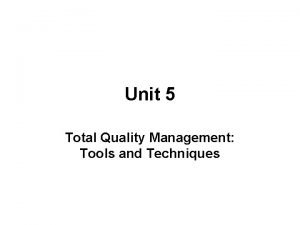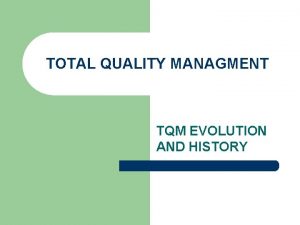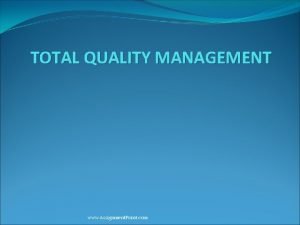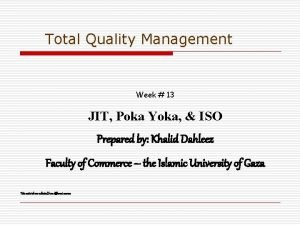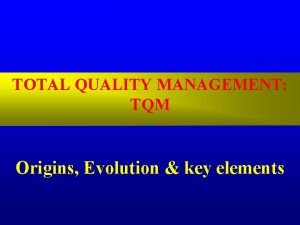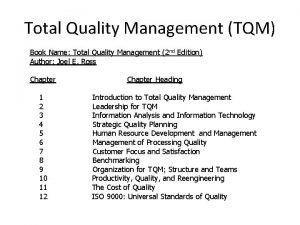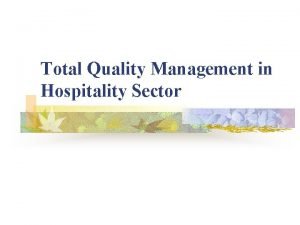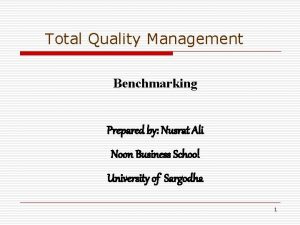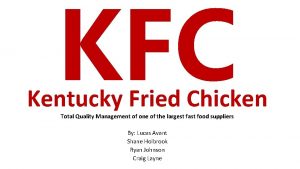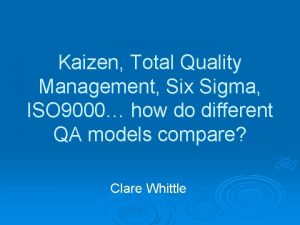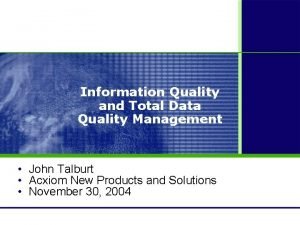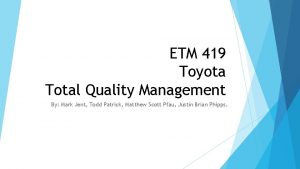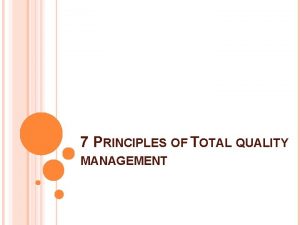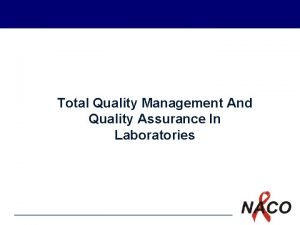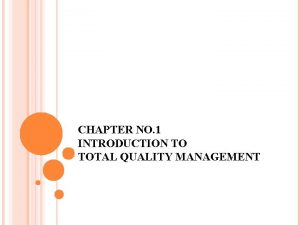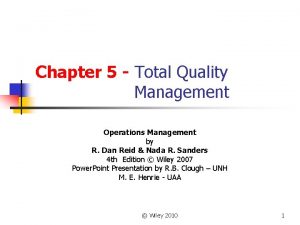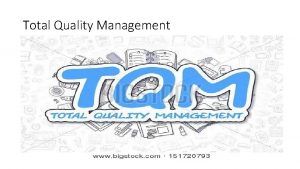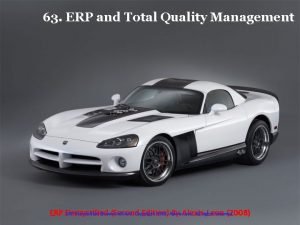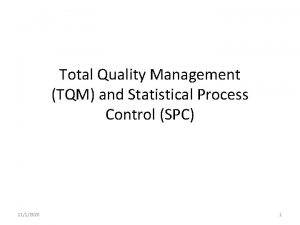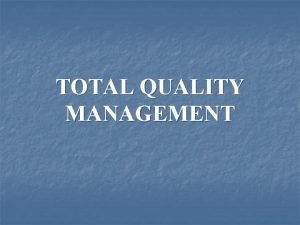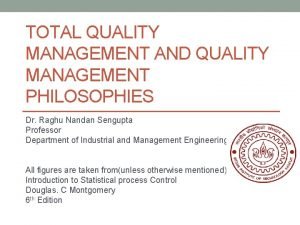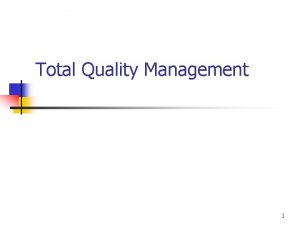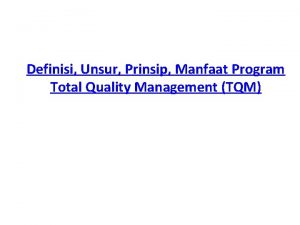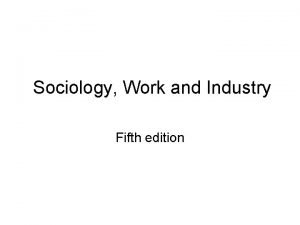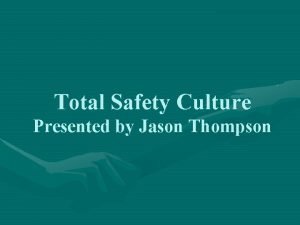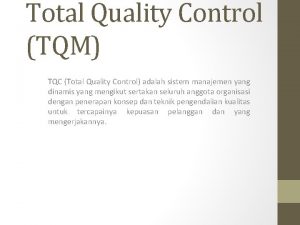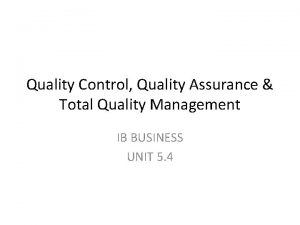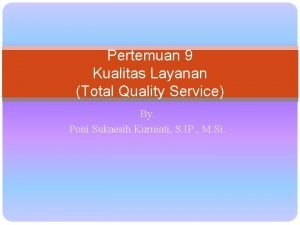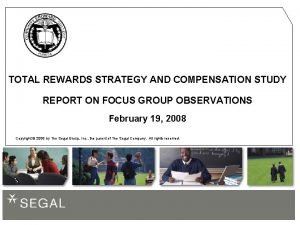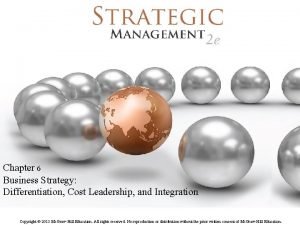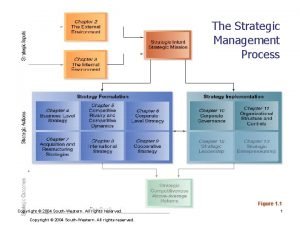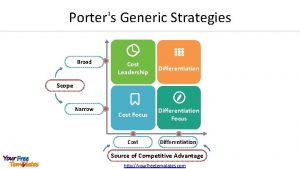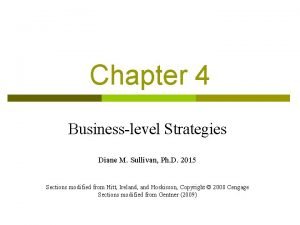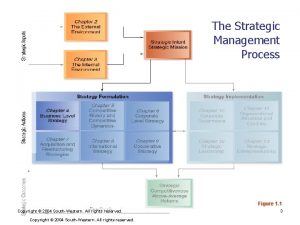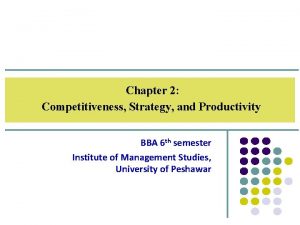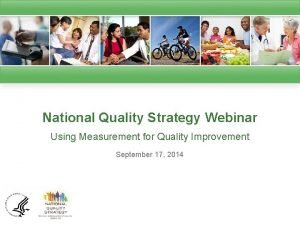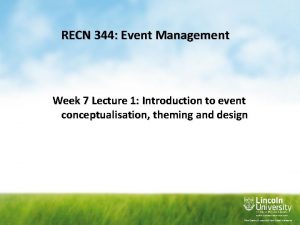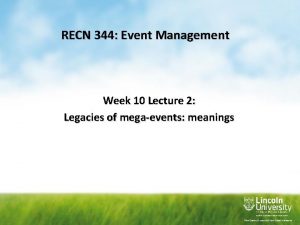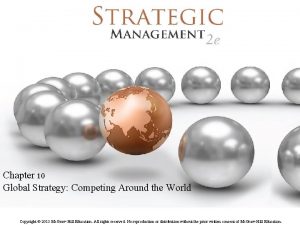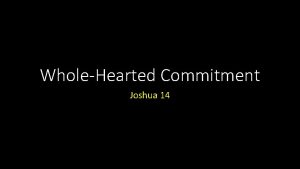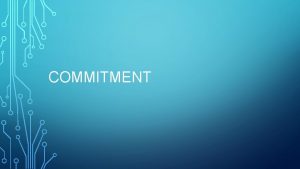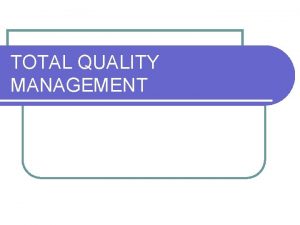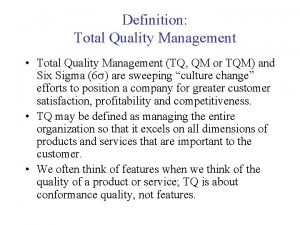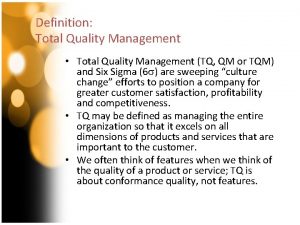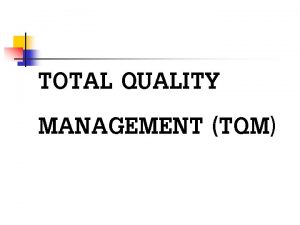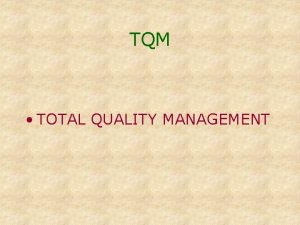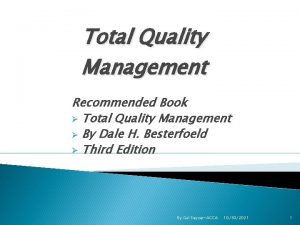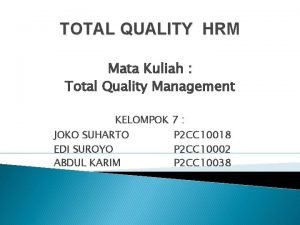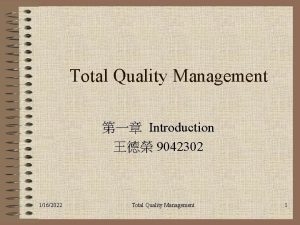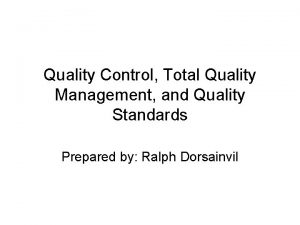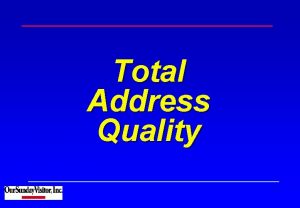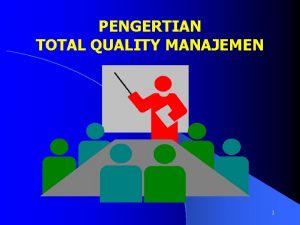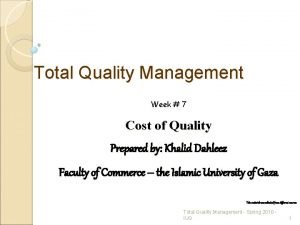Total Quality Management Week 4 Leadership Commitment Strategy










































































- Slides: 74

Total Quality Management Week # 4 Leadership, Commitment, & Strategy Prepared by: Khalid Dahleez Faculty of Commerce – the Islamic University of Gaza This material was collected from different sources Total Quality Management Spring 2010 1

Total Quality Management Model – major features Cu ltu Commitment n tio Systems ica Customer Supplier un Process mm Co re Teams Tools Total Quality Management Spring 2010 2

The total quality management approach � What is quality management? ‘something that is best left to the experts’ wrong answer � Quality cannot be achieved on a company-wide basis if it is left to the experts. � Using the traditional control techniques is NOT the way to achieve quality. � Quality is not the responsibility of the QC or QA departments only. � TQM is far more than shifting the responsibility of detection of problems from the customer to the producer. Total Quality Management Spring 2010 3

The total quality management approach � TQM requires a comprehensive approach that must first be recognized and then implemented. � Today, managers must plan strategically to maintain a hold on market share, let alone increase it. � Consumers choice quality or price? � TQM is an approach to improving the competitiveness, effectiveness and flexibility of a whole organization. � For an organization to be truly effective, each part of it must work properly together towards the same goals. Total Quality Management Spring 2010 4

The total quality management approach � The methods and techniques used in TQM can be applied throughout any organization (manufacturing, public service, health care, education and hospitality industries). �Toward TQ, management must focus on developing a problem prevention mentality. �Many people will need to undergo a complete change of ‘mindset’. �The correct mindset may be achieved by looking at the sort of barriers that exist in key areas. Total Quality Management Spring 2010 5

The total quality management approach � Staff will need to be trained and shown how to reallocate their time and energy to studying their processes in teams, searching for causes of problems, and correcting the causes, not the symptoms a positive management. � The managements of many firms may think that their scale of operation is not sufficiently large, that their resources are too slim. Total Quality Management Spring 2010 6

Quality Assessment - Questions Managers should examine the existing quality performance by asking the following questions: 1. Is any attempt made to assess the costs arising from errors, defects, waste, customer complaints, lost sales, etc? 2. Are the organization’s quality systemsdocumentation, procedures, operations etc-in good order? 3. Have personnel been trained in how to prevent errors and quality problems? 4. What is being done to motivate and train employees to do work right first time? Total Quality Management Spring 2010 7

Quality Assessment - Questions � If satisfactory answers given to most of these questions an organization in the way to using quality procedures and management. � If answers to the previous questions indicate problem areas, it will be beneficial to review the top management’s attitude to quality. � Time and money spent on quality-related activities are not limitations of profitability. Total Quality Management Spring 2010 8

Ten Points for Senior Management – TQM Foundation 1. The Organisation needs long term commitment to constant improvement. 2. Adopt the philosophy of zero errors/defects to change the CULTURE to right first time. 3. Train the people to understand the CUSTOMER SUPPLIER relationship. 4. Do not buy products or services on price alone. Look at the TOTAL cost. 5. Recognize that improvement of the SYSTEM needs to be managed. 6. Adopt modern methods of SUPERVISION and TRAINING – eliminate fear. Total Quality Management Spring 2010 9

Ten Points for Senior Management – TQM Foundation 7. Eliminate Barriers between departments by managing the PROCESS – improve COMMUNICATION and TEAMWORK. 8. Eliminate the following: • Arbitrary goals without methods, • All Standards based only on numbers, • Barriers to pride of workmanship, • Get FACTS by Using the correct TOOLS. 9. Constantly educate and retrain – develop the EXPERTS in the business 10. Develop a SYSTEMATIC approach to manage the implementation of TQM. Total Quality Management Spring 2010 10

Leadership as a Major Component of TQM Teach & Institute Leadership - Deming ◦ Leadership is management’s job. ◦ Most managers/supervisors do not truly know (how to perform) the duties of the employees they supervise. Three Steps to Quality - A. V. Feigenbaum ◦ Quality Leadership, with a strong focus on planning ◦ Modern Quality Technology, involving the entire work force ◦ Organizational Commitment, supported by continuous training and motivation Leadership can’t be delegated - Juran Total Quality Management Spring 2010 11

Leadership as a Major Component of TQM ◦ One of the main categories of Malcolm Baldrige National Quality Award (leadership – 125 points) ◦ EFQM Model (Leadership – 10%) ◦ ISO 9000 Quality Management Principles (leadership & people involvement) ◦ British Model (TQM, combined with effective leadership, results in an organization doing the right things, first time) Total Quality Management Spring 2010 12

Leadership as a Major Component of TQM �Leaders must have (Yoshio Kondo) ◦ a dream (vision and shared goals) ◦ strength of will and tenacity of purpose ◦ ability to win the support of followers ◦ ability to do more than their followers, without interfering when they can do it alone ◦ successes ◦ ability to give the right advice Total Quality Management Spring 2010 13

Leadership & Commitment � Leaders establish unity of purpose, direction, and internal environment of the organization. They create the environment in which people can become fully involved in achieving the organization´s objectives. • The ability of top management to establish, practice, and lead a long term vision for the firm, driven by changing customer requirements, as opposed to an internal management control role. • Lack of top management commitment is one of the reasons for the failure of TQM efforts (Brown et al. 1994). • A predominant requirement for quality management is that strong commitment from top management is vital. • To be an effective leader in most modern firms, the top manager must continue to develop and learn. Total Quality Management Spring 2010 14

Leadership & Commitment • Knowledge of the business and continual learning are essential prerequisites to effective leadership (Du. Brin, 1995). • In order to effectively lead the firm, top management must be committed to provide education and training to employees and regarding them as valuable resources of the firm. • Top management must be committed to allocating sufficient resources to prevent, as well as repair, quality problems. • Top management should discuss quality frequently; by having session on the topic and asking questions about quality at every staff meeting. • Top management must train and coach employees to assess, analyze, and improve work processes (Deming, Total Quality Management Spring 1986). 2010 15

Characteristics of excellent leadership Dr. Curt Reimann, director of the Malcolm Baldrige National Quality Award � Visible, committed, and knowledgeable — They promote the emphasis on quality and know the details and how well the company is doing. Personal involvement in education, training, and recognition. Accessible to and routine contact with employees, customers, and suppliers. �A missionary zeal — The leaders are trying to effect as much change as possible through their suppliers, through the government, and through any other vehicle that promotes quality. They are active in promoting quality outside the company. � Aggressive targets — Going beyond incremental improvements and looking at the possibility of making large gains, getting the whole work force thinking about different processes — not just improving Total Quality Management Spring processes. 2010 16

Characteristics of excellent leadership Dr. Curt Reimann, director of the Malcolm Baldrige National Quality Award � Strong drivers — Cycle time, zero defects, six sigma, or other targets to drive improvements. Clearly defined customer satisfaction and quality improvement objectives. � Communication of values � Organization � Customer contact — Effecting cultural change related to quality. Written policy, mission, guidelines, and other documentedstatements of quality values, or other bases for clear and consistent communications. — Flat structures that allow more authority at lower levels. Empowering employees. Managers as coaches rather than bosses. Cross functional management processes and focus on internal as well as external customers. Interdepartmental improvement teams. — CEO and all senior managers are accessible to customers. Total Quality Management Spring 2010 17

Good Leaders 1. Give priority attention to customers and their needs 2. Empower, rather than control, subordinates. 3. Emphasize improvement rather than maintenance. 4. They emphasize prevention. 5. Encourage collaboration rather than competition. 6. They train and coach, rather than direct and supervise. Total Quality Management Spring 2010 18

Good Leaders 7. Learn from problems. 8. They continually try to improve communications. 9. They continually demonstrate their commitment to quality. 10. Choose suppliers on the basis of quality, not price. 11. Establish organizational systems to support the quality effort. Total Quality Management Spring 2010 19

Role of TQM leaders All are responsible for quality improvement especially the senior management & CEO’s Ø Ensure that the team’s decision is in harmony with the quality statements of the organization Ø Senior TQM leaders must read TQM literature and attend conferences to be aware of TQM tools and methods Ø Senior managers must take part in award and recognition ceremonies for celebrating the quality successes of the organization Ø Coaching others and teaching in TQM seminars Ø Senior managers must liaise with internal , external and suppliers through visits, focus groups, surveys Ø They must live and communicate TQM. Ø Total Quality Management Spring 2010 20

Effective leadership � Effective leadership starts with the Chief Executive’s vision, capitalizing on market or service opportunities, continues through a strategy that will give the organization competitive advantage, and leads to business or service success. � Together, effective leadership and TQM result in the company or organization doing the right things, right first time. � The five requirements for effective leadership are the following: Total Quality Management Spring 2010 21

Effective leadership 1. Developing and publishing clear documented corporate beliefs and objectives – a mission statement The beliefs and objectives should address: ◦ ◦ ◦ 2. The definition of the business. A commitment to effective leadership & Quality Target sectors and relationships with customers. Indications for future direction. (principal plans) Commitment to monitoring performance against customers' needs and expectations, and continuous improvement. Developing clear and effective strategies and supporting plans for achieving the mission and objectives. Total Quality Management Spring 2010 22

Effective leadership 3. 4. 5. Identifying the critical success factors and critical processes. Reviewing the management structure Empowerment – encouraging effective employee participation particular attention must be paid to the following: A. Attitudes ◦ The key attitude for managing any winning organization may be expressed as “I will personally understand who my customers are and what are their needs and expectations of me”. ◦ This attitude must start at the top, then it must percolate down to be adopted by every employee. Total Quality Management Spring 2010 23

Effective leadership B. Abilities ◦ Every employee must be able to do what is needed and expected of him or her. ◦ Training and its effectiveness C. Participation ◦ For effective employees participation in making the company or organization successful, employees must be trained to: E Evaluate – the situation and define their objectives. P Plan – to achieve those objectives fully. D Do, implement the plans. C Check – that the objectives are being achieved. A Amend, take corrective action if they are not. Total Quality Management Spring 2010 24

Leadership: Guiding the Organization in the Pursuit of Excellence: Key Issues q Is the leadership and governance structure clearly defined and understood? q Are leaders actively engaged in campus activities? q Are senior leaders effective role models? q Are leaders actively engaged with public, professional, and/or academic groups? q Do leaders promote leadership at all levels? q Are ethics and integrity emphasized? q Are leadership goals established? q Are the organization’s pertinent legal and regulatory risks and issues addressed? q Are there informal and formal methods for reviewing leadership and governance effectiveness throughout the organization? q Do leaders encourage public responsibility and attention to the organization’s impact on the physical and social environment? Total Quality Management Spring 2010 25

Leadership benefits �for policy and strategy formulation, establishing and communicating a clear vision of the organisation's future; �for goal and target setting, translating the vision of the organisation into measurable goals and targets; �for operational management, empowered and involved people achieve the organisation's objectives; �for human resource management, having an empowered, motivated, well informed and stable workforce. Total Quality Management Spring 2010 26

LEADERSHIP FOR INSPIRING CHANGE IN QUALITY Why leadership for change? • Eighty per cent of TQM initiatives fail because they do not have the backing of the senior management. • Commitment is the foundation of an effective TQM initiative. • Leadership is the key in promoting commitment. • Leadership and commitment go hand in hand. • TQM needs leaders who are committed to change. Leadership for Total Quality - Total quality is defined as “performance leadership in meeting customer requirements by doing the right the first time. ” Total Quality Management Spring 2010 27

Change Leadership �The most challenging aspect of business is leading and managing change �The business environment is subject to fast paced economic and social change �Modern business must adapt and be flexible to survive �Problems in leading change stem mainly from human resource management �Leaders need to be aware of how change impacts on workers Total Quality Management Spring 2010 28

Leadership in TQM Role Model TRANSFORMATIONAL LEADERS TRANSACTIONAL MANAGERS: VERSUS Transformational leaders: They provide mission for others to follow and they expect the same high standards from their people. They are interested in ‘ends’ rather than ‘means’. Transactional managers: They are good at achieving short-term results, foster teamwork and work in a practical manner. Evidently, transformational leaders and transactional managers need to work together. Total Quality Management Spring 2010 29

Leadership Characteristics Jim Collins, “Good To Great” �Level One ◦ Highly capable ◦ Contributes through talent, knowledge, skills, and good work habits �Level Two ◦ Team member ◦ Contributes individual capabilities to the group and works effectively with others �Level Three ◦ Competent manager ◦ Organizes people and resources toward the effective and efficient pursuit of predetermined objectives Total Quality Management Spring 2010 30

Leadership Characteristics Jim Collins, “Good To Great” �Level Four ◦ Catalyst leader ◦ Makes a commitment to and vigorous pursuit of a clear and compelling vision, stimulating higher performance standards �Level Five ◦ Executive leader ◦ Builds enduring greatness through a paradoxical blend of personal humility and professional will Total Quality Management Spring 2010 31

How all leaders drive the organisation towards a position of Business Excellence Give & Receive Training Develop Goals Communicate Effectively Leadership Make Themselves Accessible Recognition Listen & Respond to People Total Quality Management Spring 2010 32

Comparison of Traditional Management and TQM S. 1. NAspect o. Quality definition Traditional Management TQM (a) Products meet specifications. (a) Products fit for customer us. (b) Focus on post-production inspection. (b) Focus on building quality into the work process. 2. Customers Ambiguous understanding of customer requirements. Systematic approach to seek, understand satisfy internal and external customers. 3. Errors A certain margin of error, waste and rework is tolerable. No tolerance for errors: do it right the first time and every time approach. 4. Improvement emphasis Technological break-through such as automation. Gradual but continuous improvement of each function. 5. Problem solving Unstructured problem solving and decision making by individual managers and specialists. Participative and disciplined problem solving and decision making based on hard data. Total Quality Management Spring 2010 33

STRATEGY AND THE STRATEGIC PLANNING PROCESS � Evidence suggests that those companies with strategies based on TQM have achieved stunning successes. � Most of these successful companies will attribute their progress to a quality based strategy that was developed through a formal structured approach to planning. � Total Quality begins with a strategic decision — a decision that can only be made by top management — and that decision, simply put, is the decision to compete as a world class company. Total Quality concentrates on quality performance — in every facet of the business — and the primary strategy to achieve and maintain competitive advantage. It requires taking a sys‑tematic look at an organization — looking at how each part interrelates to the whole process. In addition, it demands con tinuous improvement as a “way of life. ” Total Quality Management Spring 2010 34

STRATEGY AND THE STRATEGIC PLANNING PROCESS Professors Andrews, Christensen, and others in the Policy group at the Harvard Business School argue that corporate strategy is the pattern of decisions in a company that: (1) determines, shapes, and reveals its objectives, purposes, or goals; (2) produces the principal policies and plans for achieving these goals; and (3) defines the business the company intends to be in, the kind of economic and human organization it intends to be, and the nature of the economic and non eco nomic contribution it intends to make to its shareholders, employees, customers, and communities. Total Quality Management Spring 2010 35

STRATEGY AND THE STRATEGIC PLANNING PROCESS �Michael Porter describes the development of a competitive strategy as “a broad formula for how a business is going to compete, what its goals should be, and what policies will be needed to carry out those goals. ” �Strategic Planning is a deliberate process used by organizations to develop a mission, vision, guiding values, strategic objectives, and specific strategies for achieving the objectives. Total Quality Management Spring 2010 36

Strategic Planning Strategic business planning is similar to strategic quality planning. 7 steps to strategic planning 1. 2. 3. 4. 5. 6. 7. Customer needs Customer positioning Predict the future Gap analysis Closing the gap Alignment Implementation Total Quality Management Spring 2010 37

TQM Strategy Approach � an approach to improving the competitiveness, effectiveness and flexibility of a whole organisation. . . a way of planning, organising and understanding each activity and it depends on each individual at each level. TQM is a way of. . . bringing everyone into the processes of improvement (Oakland 1995) � a TQM programme promotes "quality" as a strategic imperative. Comprehensive TQM programme requires re evaluation how organisational members address the quality of their work and production /service Total Quality Management Spring processes. 2010 38

TQM supported by policy commitment � culture & practice � change strategy & organisational renewal � injection of energy � staff encouraged to practice positive, initiative taking behaviours � a prevention ethic � quality improvement teams/circles � use of methods and techniques (tools) Total Quality Management Spring 2010 39

The organisations mission, values, strategic direction & the manner in which it achieves them Employees Suppliers Customers Benchmarking Use Appropriate Information Legislation Competitors Set Targets Communicate to all Strategy & Planning Review & Improve Develop Changes Check Understanding Total Quality Management Spring 2010 40

Determine strategic intent Define organizational mission Strategic Managemen t Process Analyze environment Set objectives Determine requirements Assess resources Develop action plans Implement plans Strategic Planning Monitor outcomes Feedback Total Quality Management Spring 2010 41

FACTORS DETERMINING COMPETITIVE STRATEGY STRENGTHS & WEAKNESSES OPPORTUNITIES & THREATS Factors Internal External COMPETITIVE STRATEGY to the Company PERSONAL VALUES BROADER SOCIETAL EXPECTATIONS Total Quality Management Spring 2010 42

Objective Setting through SWOT ANALYSIS Internal Strengths Weaknesses External Opportunities Threats SWOT Total Quality Management Spring 2010 43

STRATEGIC PLANNING PROCESS (major questions) Following a SWOT analysis, the strategic plan will involve a process to search for the answers to the following questions: 1. Who are we? 2. What are we known for? 3. What do we do better than 90% of our competitors? 4. What do our competitors beat us on? 5. What do we wish to be known for? 6. Where are we headed as an organization? 7. Where do we wish to be headed? 8. How would we get there? 9. What would it take to get us there? Total Quality Management Spring 2010 44

Components of Strategy The major role that quality plays in strategic planning can best be understood by examining the components of a strategy: ◦ Mission, vision, and guiding values ◦ Product/market scope ◦ Competitive edge (differentiation) ◦ Supporting policies ◦ Objectives ◦ Organizational culture Total Quality Management Spring 2010 45

Quality statements Besterfield �The quality statements include the vision statement, mission statement, and quality policy statement. �Once developed, they are only occasionally reviewed and updated. They are part of the strategic planning process. �There may be considerable overlap among the three statements. Total Quality Management Spring 2010 46

Quality statements Vision statement a short declaration of what the organization hopes to be tomorrow Mission statement – a statement of purpose –who we are, who are our customers, what we do , and how we do it. Quality policy – is a guide for everyone in the organization , how they should provide products and services to the customers. Total Quality Management Spring 2010 47

Quality Statements 1. Vision statement : is the declaration of what an organization should look like five to ten years in the future. 2. Mission statement : answers the questions that who we are , who are the customers , what we do and how we do it. This statement is usually one paragraph or less in length , is easy to understand describes the function of the organization. 3. Quality policy statement : is a guide for everyone in the organization as to how they should provide products and service to the customers It should be written by CEO with feed back from work force and be approved by quality council. Total Quality Management Spring 2010 48

STRATEGIC QUALITY MANAGEMENT (Environment) Environment �The major determinant of a mission is the environment in which the firm plans to operate: the general environment, the industry environment, and the competitive environment. Strategy is essentially the process of posi tioning oneself in that environment as trends and changes unfold. Thus, it is necessary to identify trends in the environment and how they affect the strategy of the firm. Total Quality Management Spring 2010 49

STRATEGIC QUALITY MANAGEMENT Product/Market Scope �This answers the questions: What am I selling and to whom am I selling it? The answers are more complex than they appear. �in today’s heightened competitive environment, a product or service is not simply sold to anyone who will buy it. �To be effective, value must be sold to a particular market or customer segment. �Strategic planning involves the determination of these strategy components, and quality plays a major role in this process. Total Quality Management Spring 2010 50

Vision statement: �A short declaration of what an organization aspires to be in the future. It is an ideal state that an organization continually strives to achieve. It is timeless, inspirational, and becomes deeply shared within the organization. � Successful vision – a concise statement of the desired end – provides a succinct guideline for sound decision making. � Although mission and vision are often used as synonymous, sometimes a distinction is made in which case mission evolves from the vision. � Example: “We will be the provider of safe, reliable, cost effective products and services that satisfy the electric related needs of all customer segments. ” [Florida Power & Light Company]. Total Quality Management Spring 2010 51

Vision statement: �A vision reflects where the organization is headed or wishes to be. It is like a destination dreamed up by the organization. Every decision made by the organization must be informed by its vision. An organization’s �vision must come from top management, and must be well articulated and understood by all. The guiding values reflect the beliefs that shape and mold the decisions and choices an organization makes. Total Quality Management Spring 2010 52

Mission statement: �The mission statement answers the following questions: who we are, who are our customers, what we do, and how we do it. �This statement is usually one paragraph or less in length, is easy to understand, and describes the function of the organization. It provides a clear statement of purpose for employees, customers, and suppliers. Example: “Our mission is to improve continually our products and services to meet our customers’ needs, allowing us to prosper as a business and provide a reasonable return to our shareholders. ” [Ford Motor Company]. Total Quality Management Spring 2010 53

Mission statement: The mission is the primary overall purpose of an organization and its expressed reason for existence. The simplest statement of mission might be to “meet the needs/values of constituents. ” Example: The mission of NCR is stated simply: “Create Value for Our Stakeholders. ” Stakeholders are identified as employees, share holders, suppliers, communities, and customers. 13 The mission can be operationalized by statements of how it will be imple mented for each stakeholder. Total Quality Management Spring 2010 54

Mission & Vision �If the vision deals with ‘what’, the mission deals with ‘why’ and ‘how’. It identifies the roles or activities to which an organization is committed and provides overall direction for achieving the mission. �The mission provides the guide map, milestones for achieving the vision. Example: “To be the leading manufacturer and supplier of measurement and computing solutions whilst achieving the highest levels of customer satisfaction, quality, and business ethics and contributing to India’s technological, economic and social needs. ” [Hewlett Packard India]. Total Quality Management Spring 2010 55

Quality policy statement: Besterfield �The quality policy is a guide for everyone in the organization as to how they should provide products/service to the customers. It is written after obtaining feedback from the workforce and is approved by the quality council. �A quality policy is a requirement of ISO 9000. �Some common characteristics are: ‘Quality is first priority’; ‘Continually improve the quality’; ‘Equal or exceed the competition’; ‘Meet the needs of internal and external customers’, etc. Total Quality Management Spring 2010 56

Quality policy statement: �Example: “Xerox is a quality company. Quality is the basic business principle of Xerox. Quality means providing our external and internal customers with innovative products and services that fully satisfy their requirements. Quality is the job of every employee. ” [Xerox Corporation]. Total Quality Management Spring 2010 57

Vision & Plan Statement Vision statement describes how a firm wants to be seen in its chosen business. Vision describes standards, values, and beliefs of the organization. Intent of a vision statement is to communicate the firm’s values, aspirations and purpose, so that employees can make decisions that are consistent with and supportive of these objectives. Plan statement is a detailed road map of actions; what and how organization intended execute that plan in future. Organization may have many kinds of plan; Strategic business performance plan Quality goal plan Quality improvement plan Total Quality Management Spring 2010 58

Vision & Plan Statement Strategic business performance plan can be divided into long and short term business performance plans that include, for example, market share, profits, annual sales, exports, and sales growth. Quality goal plan can involve, for example, conformity rate, defect rate, internal failure costs, external failure costs, performance, reliability, and durability. Quality improvement plan aims for quality improvement, which are actions taken throughout the organization to increase the effectiveness and efficiency of activities and processes in order to provide added benefits to both the organization and its customers (ISO 8402, 1994). Total Quality Management Spring 2010 59

Strategic Quality Goals and Objectives v. Goals must be focused v. Goals must be concrete v. Goals must be based on statistical evidence v. Goals must have a plan or method with resources v. Goals must have a time frame v. Goals must be challenging yet achievable Total Quality Management Spring 2010 60

Top Management Commitment �Above all, demonstration of commitment by top management is essential. This commitment is demonstrated by behaviors and activities that are exhibited throughout the company. Categories of behaviors include the following: ◦ Signaling — Make statements or take actions that support the vision of quality, such as mission statements, creeds, or charters directed toward customer satisfaction. Publix supermarkets’ “Where shopping is a pleasure” and JC Penney’s “The customer is always right” are examples of such statements. Total Quality Management Spring 2010 61

Top Management Commitment � Focus — Every employee must know the mission, his or her part in it, and what has to be done to achieve it. What management pays attention to and how management reacts to crisis is indicative of this focus. When all functions and systems are aligned and when practice supports the culture, everyone is more likely to support the vision. Johnson and Johnson’s cool reaction to the Tylenol scare is such an example. � Employee policies — These may be the clearest expression of culture, at least from the viewpoint of the employee. A culture of quality can be easily demonstrated in such policies as the reward and promotion system, status symbols, and other human resource actions. Total Quality Management Spring 2010 62

Commitment and policy � TQM must start at the top with the chief Executive or equivalent. � The Leader (Top Management) is responsible for coordination the work between the different departments in the company (Marketing, Design Production, Purchasing, Distribution, and Service Functions). � The middle management must explain the principles of TQM to the people for whom they are responsible, and ensure that their own commitment is communicated. � The chief Executive must accept the responsibility for and commitment to a quality policy in which he must really believe. � Within each and every department of the organization at all levels, starting at the top, basic changes of attitude will be required to operate Total Quality Management Spring 2010 63 TQM.

Commitment and policy � Controls, systems and techniques are very important in TQM, but they are not the primary requirement. � TQM requires from the management total commitment, which must then be extended to all employees at all levels and in all departments. � Going into organizations sporting postercampaigning for quality instead of belief, one is quickly able to detect the falseness. � The opposite is an organization where TQ means something, can be seen, heard, felt. � Commitment is an essential element of a TQM drive. Commitment must exist at every level. it is adherence to plans, principles and procedures. Total Quality Management Spring 2010 64

Supporting Policies �Policies are guidelines for action and decision making that facilitate the attainment of objectives. Taken together, a company’s policies delineate its strategy fairly well. Tell me your policies and I can tell your strategy. �A firm’s policy choices are essential as drivers of differentiation. They determine what activities to perform and how to perform them. Total Quality Management Spring 2010 65

Supporting Policies �The role of policies as a critical element of strategy is displayed in the policy wheel. �In the center are the mission (the purpose of the organization), the differentiation (how to compete in the market), and the key objectives of the business. The spokes of the wheel represent the functions of the business. �Each function requires supporting policies (functional strategies) to achieve the hub. If the firm’s strategy calls for competing on quality, then this becomes the impetus for policy determination. �Each functional policy supports this central strategy and the objectives that are determined during the planning process. Total Quality Management Spring 2010 66

Supporting Policies The quality policy: � Every organization should develop and state its policy on quality, together with arrangements for its implementation. � The contents of the policy should be made known to all employees. � Management must be dedicated to the regular improvement of quality, not simply a one-step improvement to an acceptable plateau. Total Quality Management Spring 2010 67

Supporting Policies Ideas must be set out in a quality policy that requires top management to: � 1. 2. 3. 4. 5. 6. 7. � Establish an ‘organization’ for quality. Identify customer’s needs and perception of needs Assess the ability of the organization to meet these needs economically. Ensure that bought in materials and services reliably meet the required standards of performance and efficiency. Concentrate on the prevention rather than detection philosophy. Educate and train for quality improvement. Review the quality management systems to maintain progress. The quality policy must be publicized and understood at all levels of the organization. Total Quality Management Spring 2010 68

Elements of a Quality Policy � organisation structure for quality: roles, responsibilities � how client/customer needs & perceptions are identified � product service development � technical/economic resource allocation � QMS scheme & operation � how suppliers & supplies are required to meet standards � prevention & zero defects � communication, knowledge, information & staff development � audit of QMS in operation � partnership with staff, customers & suppliers. Total Quality Management Spring 2010 � physical manifestation not just conceptual 69

STRATEGIC QUALITY MANAGEMENT (Competitive Advantage) Differentiation � Michael Porter, in his landmark book Competitive Strategy, identified two generic competitive strategies: (1) overall cost leadership and (2) differentiation. Cost leadership in turn can be broad in market scope (e. g. , Ivory Soap, Emerson Electric, Black & Decker) or market segment focused (e. g. , La Quinta Motels, Porter Paint). � The second strategy involves differentiating the product or service by creating something that is perceived by the buyer as unique. � Differentiation, frequently called the competitive edge, answers the question: Why should I buy from you? � Differentiation can also be broad in scope (American Airlines in on time service, Caterpillar for spare parts support) or focused (e. g. , Godiva chocolates, Mercedes automobiles). � Thus, there are four generic strategies, but each depends on something different — something unique or distinguishing. Even an effective cost leadership strategy must start with a good product. Total Quality Management Spring � 2010 70

STRATEGIC QUALITY MANAGEMENT (Competitive Advantage) ◦ Differentiation may depend on one or more or a combination of Quality dimensions (Performance, Features, Reliability, Conformance, Durability, Serviceability, Aesthetics, Perceived quality); ◦ but the point is that when differentiating based on quality, quality must be defined in terms that meet customer expectations, even if this is only what the customer perceives as quality. Total Quality Management Spring 2010 71

STRATEGIC QUALITY MANAGEMENT (Competitive Advantage) Market Segmentation (Niche) Quality �Quality means different things to different people. In terms of strategic quality management, this means that the firm must define that segment of the industry, that generic strategy, and that particular customer group which it intends to pursue. This can be called a segmented quality strategy. Total Quality Management Spring 2010 72

WHEEL OF COMPETITIVE STRATEGY Product Line Target Markets Marketing Finance & Control Sales Differentiation Mission GOALS R&D Distribution Purchasing Mfging Labor Competitive Strategy is a combination of the Ends (Goals) for which the firm is striving and the Means (Policies) by which is it seeking to get there Total Quality Management Spring 2010 1

Summary Slide �The following Slides are for understanding only (subject to indirect Questions): “ 9, 10, 14, 15, 18, 19, 20, 25, 26, 27, 28, 33” �Other slides are required and subjects to any type of Questions Total Quality Management Spring 2010 74
 Total quality management ppt
Total quality management ppt What is tqm
What is tqm Quality statement examples
Quality statement examples Total quality management tools
Total quality management tools Tqm inventor
Tqm inventor Assignment point
Assignment point Definition of just in time
Definition of just in time Total quality managment
Total quality managment Evolution of total quality management
Evolution of total quality management Introduction to tqm
Introduction to tqm Total quality management founder
Total quality management founder Total quality management in hospitality industry
Total quality management in hospitality industry Benchmarking in total quality management
Benchmarking in total quality management Gurus of tqm
Gurus of tqm Quality assurance model in nursing
Quality assurance model in nursing Kfc total quality management
Kfc total quality management Six sigma vs iso 9000
Six sigma vs iso 9000 Total data quality management
Total data quality management Quality management toyota
Quality management toyota 7 principles of quality management system
7 principles of quality management system How to achieve tqm
How to achieve tqm Introduction of total quality management
Introduction of total quality management Qfd in total quality management
Qfd in total quality management Total quality management wikipedia
Total quality management wikipedia Erp demystified
Erp demystified Agricultural quality management
Agricultural quality management Spc in total quality management
Spc in total quality management Introduction to tqm
Introduction to tqm Philosophies of total quality management
Philosophies of total quality management Philosophies of total quality management
Philosophies of total quality management Definisi total quality management
Definisi total quality management Week by week plans for documenting children's development
Week by week plans for documenting children's development High commitment management model
High commitment management model Formula de roe
Formula de roe Total revenues minus total costs equals
Total revenues minus total costs equals Total revenues minus total costs equals
Total revenues minus total costs equals Total revenues minus total costs equals
Total revenues minus total costs equals Total revenue minus total expenses
Total revenue minus total expenses Dr jason thompson
Dr jason thompson Transactional leadership vs transformational leadership
Transactional leadership vs transformational leadership Adaptive leadership characteristics
Adaptive leadership characteristics Adaptive leadership vs situational leadership
Adaptive leadership vs situational leadership Contoh tqc
Contoh tqc Youtube.com
Youtube.com Total quality service adalah
Total quality service adalah Motivating people for total quality
Motivating people for total quality Quality management in operations management
Quality management in operations management Perform quality assurance
Perform quality assurance Quality management pmp
Quality management pmp Pmbok quality assurance vs quality control
Pmbok quality assurance vs quality control Quality improvement vs quality assurance
Quality improvement vs quality assurance Qa basic concepts
Qa basic concepts Quality is free
Quality is free Old quality vs new quality
Old quality vs new quality Total rewards strategy presentation
Total rewards strategy presentation Drivers of differentiation
Drivers of differentiation Cost leadership strategy
Cost leadership strategy Differential low-cost access to productive inputs
Differential low-cost access to productive inputs Functional structure
Functional structure Broad cost leadership strategy
Broad cost leadership strategy Diane m sullivan
Diane m sullivan Cost leadership strategy
Cost leadership strategy Porters strategies
Porters strategies Competitiveness strategy and productivity
Competitiveness strategy and productivity Cdc hhs
Cdc hhs Management week event
Management week event Management week event
Management week event Business strategy vs corporate strategy
Business strategy vs corporate strategy Global matrix structure
Global matrix structure Chase strategy formula
Chase strategy formula What is multidomestic strategy
What is multidomestic strategy Aligning hr strategy with business strategy
Aligning hr strategy with business strategy Porter's diamond model international business
Porter's diamond model international business Managerial process of crafting and executing strategy
Managerial process of crafting and executing strategy Strategy formation
Strategy formation



